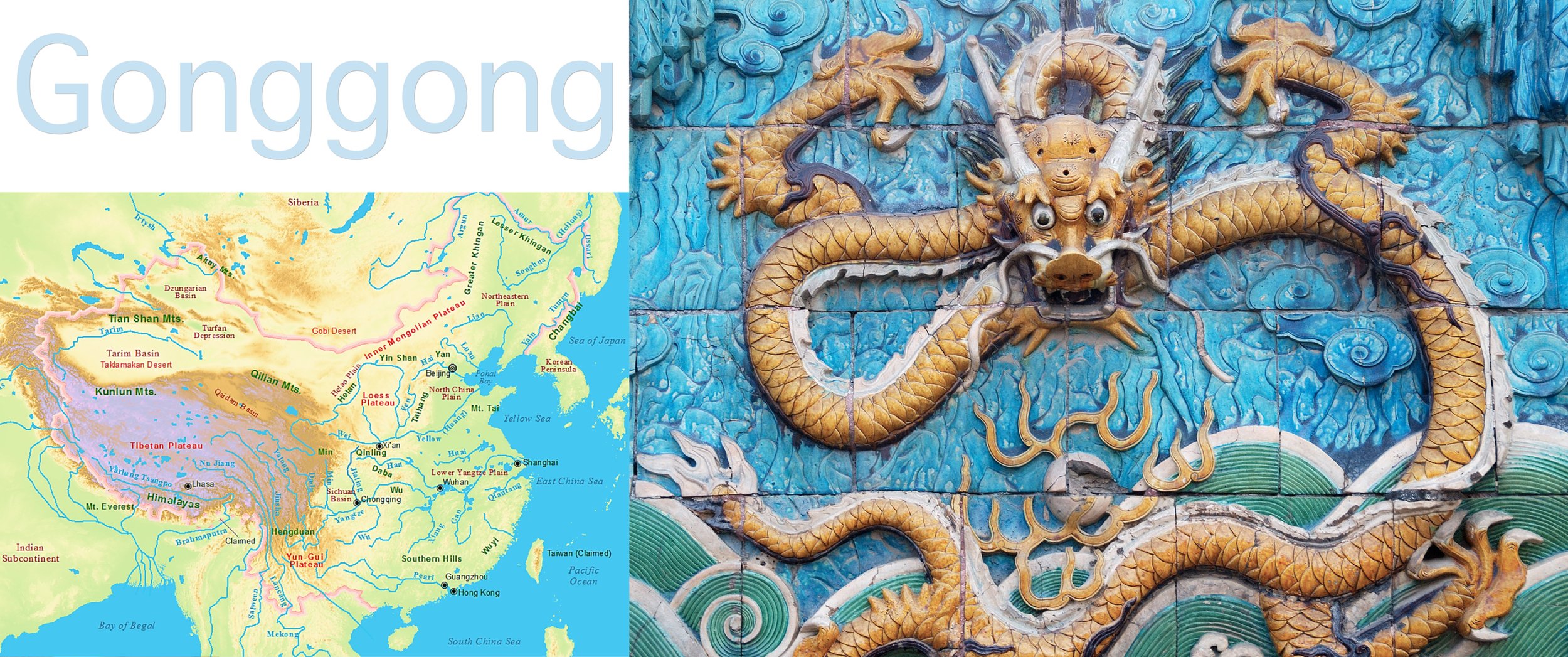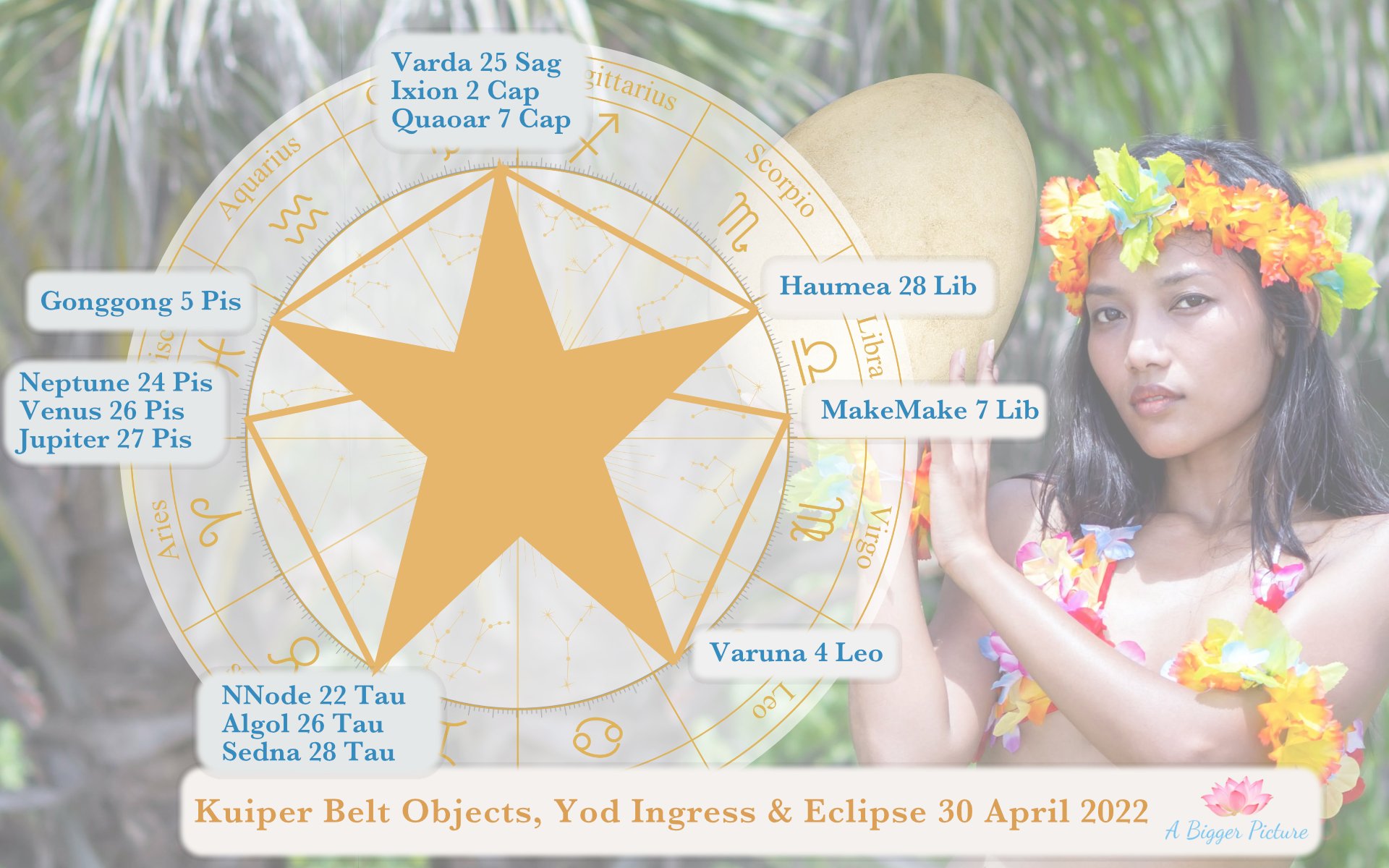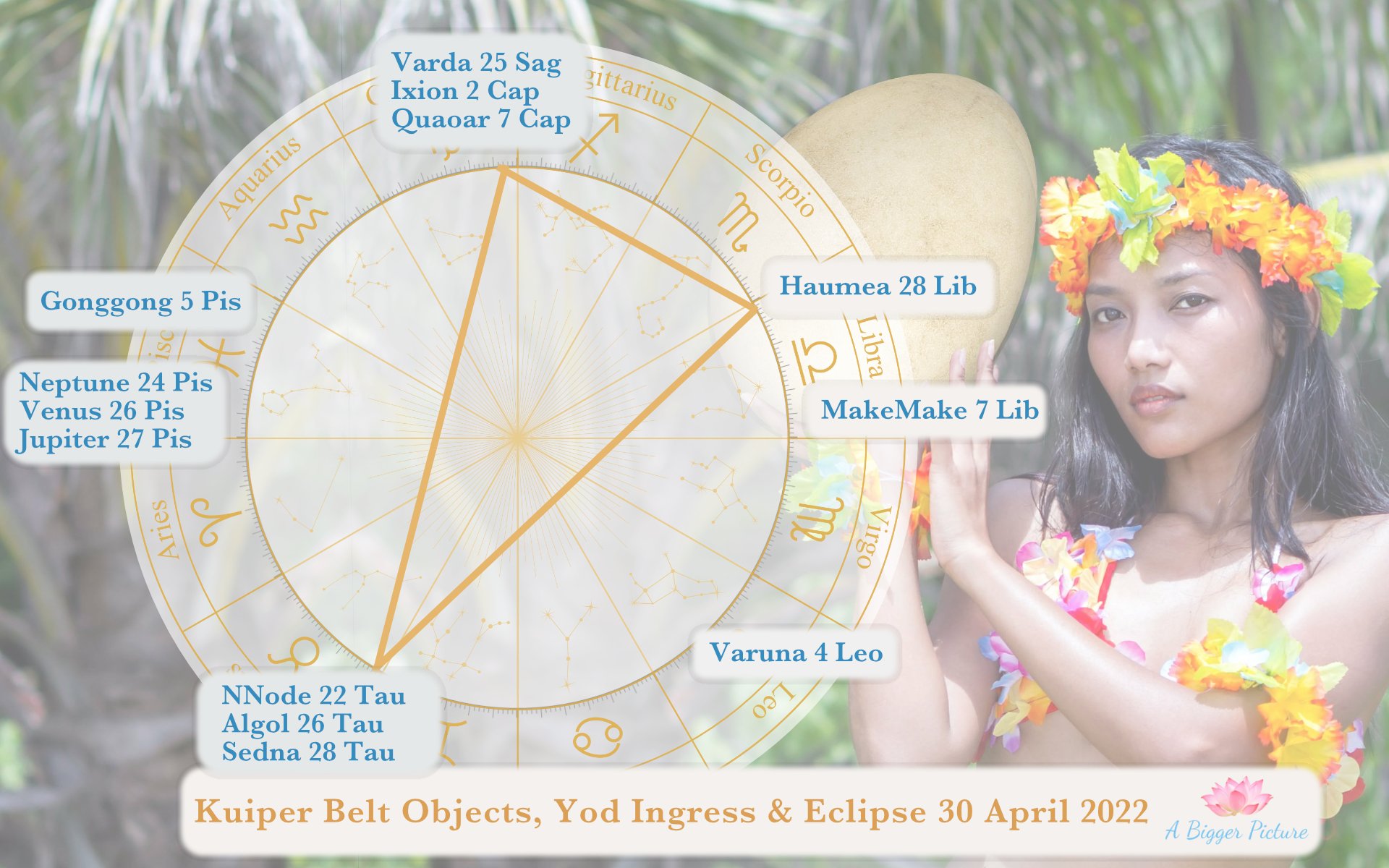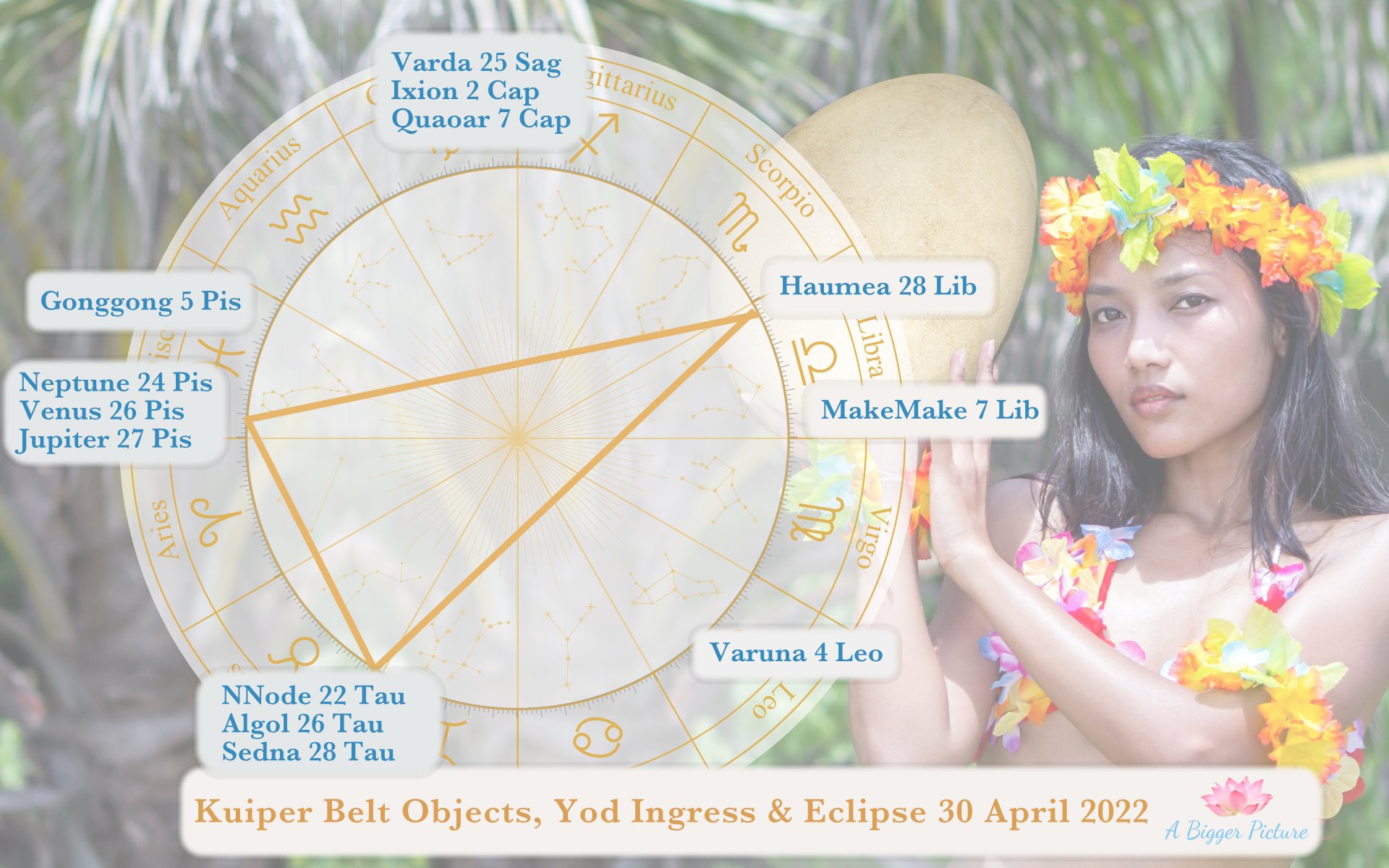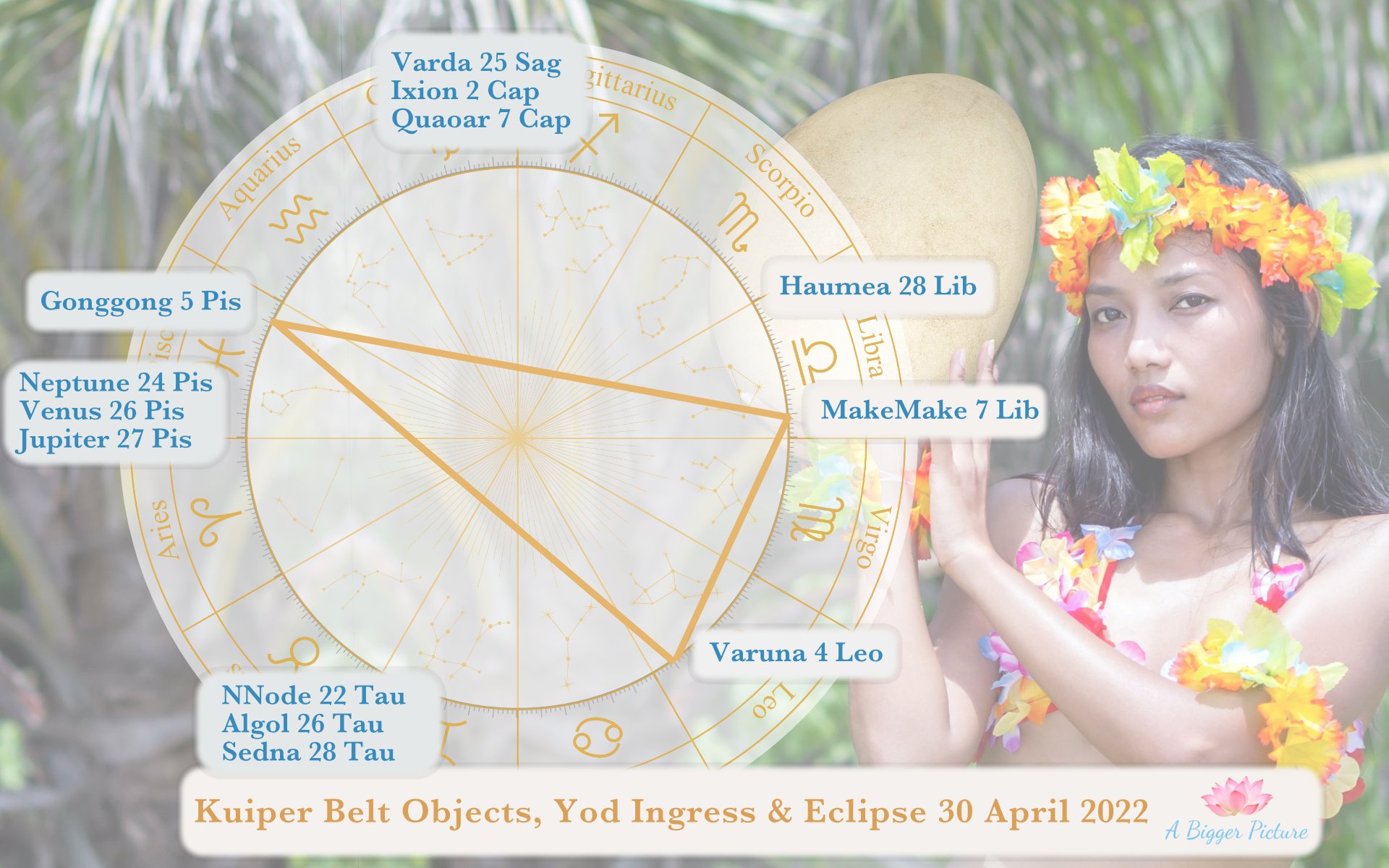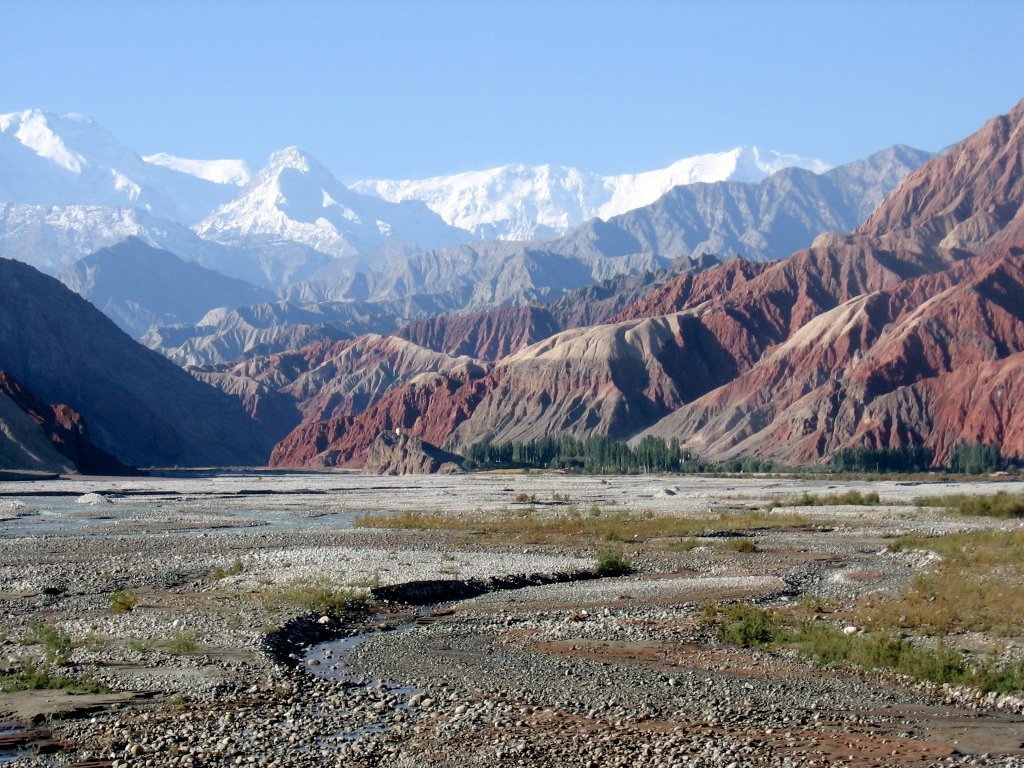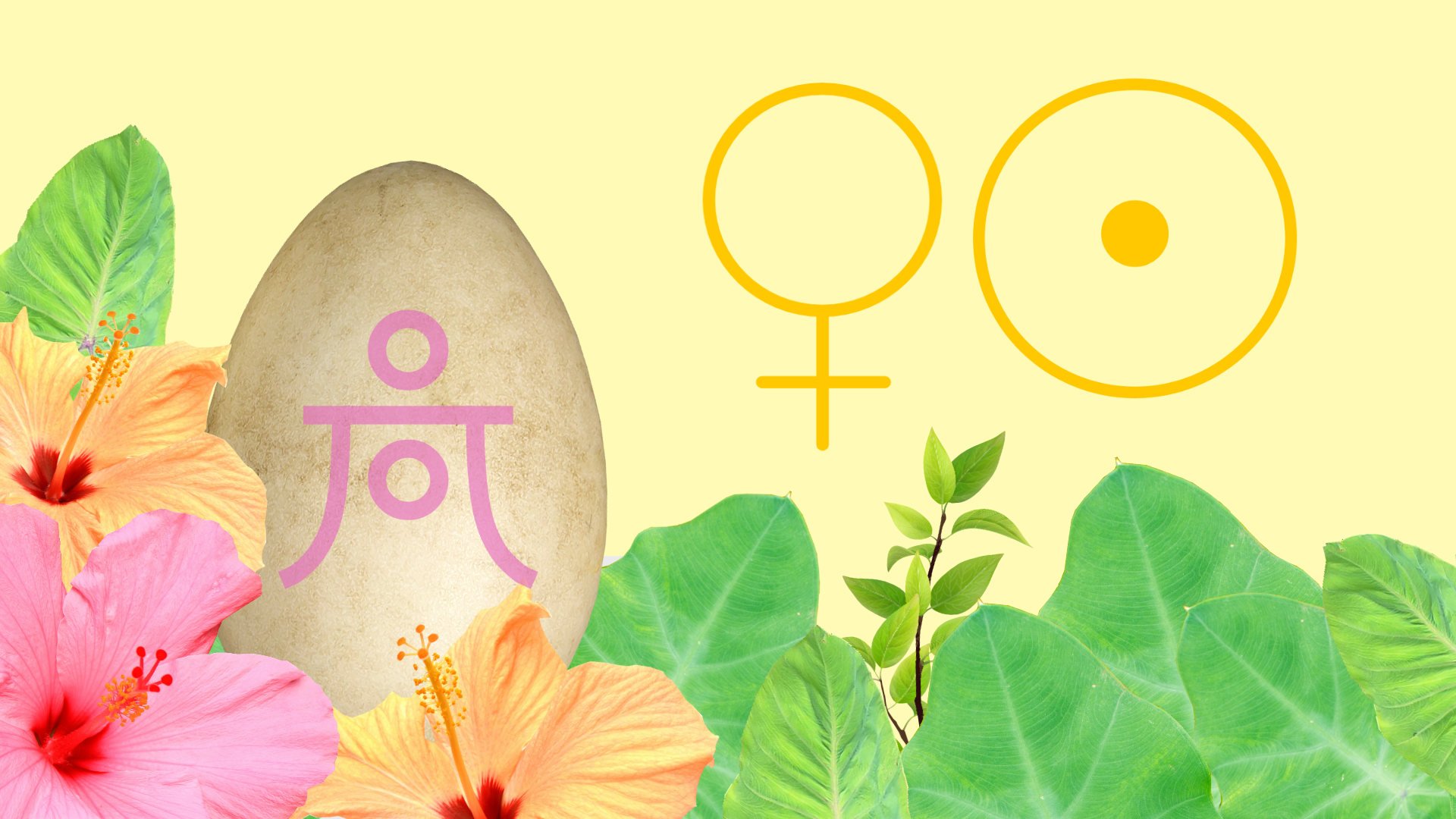Gonggong the Chinese Water god, Trans-Neptunian Object and Discovery Chart Part 2
Gonggong was a short-tempered Chinese water god responsible for chaos that led to floods, landslides, and the tilt of the Earth in ancient Chinese legends.
He is the dragon or demon who is most famous for knocking the planet out of kilter and thus causing the seasons, precession of the equinoxes, and devastating floods.
This is part two about dwarf planet 225088, discovery code “2007 OR10'“ nicknamed ‘Snow White’ that was discovered in 2007, and after a naming competition was issued, is named after the ancient Chinese water god Gonggong.
(Find Part 1 here.) Gonggong is currently at an apex of a Yod from MakeMake in Libra, and Varuna in Leo. Yods carry a strong sense of destiny and focussed energy.
This article contains information from the second online course about trans-Neptunian and Kuiper Belt Objects.
This information is provided for free due to its importance and significance as many countries are experiencing extreme flooding and millions are reportedly displaced.
Naturally there is going to be a questioning about the astrological significance regarding all the flooding, landslides and chaos due to too much water, but major details are in the paid content of the online course.
This course is about the significant four Yods and the three Hammer of Thor aspect patterns that influences us here on planet earth from 2020 - 2030+.
The new course is all about the strange mixed bag of energies we’ve been having since the start of 2020.
Transits to Gonggong in Pisces, Floods, and a Climate of Change
The Gonggong Yod came into 3 degree orb afforded a Yod around mid 2016 when Varuna moved into Leo, however Yods like this are often only highly pronounced when in tight orb, and towards the end of them being in tight orb. On August 2020 to mid 2022, Gonggong at 5 degrees Pisces has been at the apex of the Gonggong Yod in tight orb…
At the time of writing, Gonggong was at 5 degrees Pisces, the apex of a Yod from MakeMake at 6 degrees Libra and Varuna at 5 degrees Leo. Together they are part of an elaborate five pointed star of Yods in the astrological sky.
Since the start of 2020, three Yods and three Hammer of Thor aspects have formed in the sky, joined by a fourth Yod with Haumea in Libra at the apex on 30 April 2022 at the Venus, Jupiter and Neptune conjunction in Pisces. Learn about the majestic configuration below in the new online course about the trans-Neptunian planets and Kuiper belt objects. There is also a course about the Yod to Haumea, that is meant to be a detailed teaching tool on how to interpret a Yod, which is potentially the most complex astrological configuration out there, and challenging to understanding.
A June 2022 report out of China say that the heaviest rainfall in over 60 years has hit southern China. 30% more rainfall than usual was reported across China in June. 85 rivers across China reported flooding above warning levels as of noon June 20. Ironically, another report from the end of June 2022, was titled “The sky is attacking China”, and shows a massive windstorm with gusts of 20 metres per second.
It is during a Yod apex forming on a specific new planet, that astrological researchers can get a good grasp on what the energy of it entails… for the astrological understanding and benefit of all, and in 2024 and 2026 there will be great opportunities to observe and learn.
To get more on the dates and highlights regarding Gonggong, see the online courses page on this website.
A lot of information has been generously provided in this free public article, but the details are in the online course, because this website and all its expensive stock images and video, has to pay for itself, in order to keep ABiggerPicture.com moving into the future. So please support this in reciprocity, by purchasing some of the online courses.
Snow White’s Discovery Information
The dwarf planet 225088 was discovered in 2007 is named after Gonggong.
It was given the provisional name 2007OR10, originally nicknamed ‘Snow White’. Wikipedia reveals that Gonggong was discovered by American astronomers Megan Schwamb, Michael Brown and David Rabinowitz on 17 July 2007.
Wikipedia describes that the object is named after Gonggong, a water god in Chinese mythology. Gonggong is depicted as having a copper-and-iron, red-haired human head (or sometimes torso) and the body or tail of a serpent. Gonggong was responsible for creating chaos and catastrophe, causing flooding and tilting the Earth, until he was sent into exile. Gonggong is often accompanied by his minister, Xiangliu, a nine-headed poisonous snake monster who was also responsible for causing flooding and destruction.
Before its official naming, Gonggong was the largest known unnamed object in the Solar System. Initially after the discovery of Gonggong, astrolomer Mike Brown nicknamed the object "Snow White" for its presumed white color based on his assumption that it may be a member of the icy Haumea collisional family. The nickname also fitted because, by that time, Brown's team had discovered seven other large trans-Neptunian objects which were collectively referred to as the "seven dwarfs": Quaoar in 2002, Sedna in 2003, Haumea, Salacia and Orcus in 2004, and Makemake and Eris in 2005. However, Gonggong turned out to be very red in color, comparable to Quaoar, so the nickname was dropped.
Yet there is another association. When the air hits the mountains in the North West in Gonggong’s legend, it creates snow on the mountains, which become the rainwater that breaks the banks and cause destruction. Therein lies the key in understanding the snow and climate change connection.
What was thought to be a mistake, is not, its a synchronicity amplifying a truth…
The fact that Snow White was initially thought of as “unremarkable” despite its size, adds strength to the idea that at the heart of Gonggong energy, there seems to be a high sensitivity and orientation towards situations of uncertainty, that is rooted in an ongoing, big picture process; where the final result is very difficult to predict, control, mitigate or handle appropriately, especially when potentially moving towards, or are at, disaster level. What initially appeared to be just an innocent white-looking, object, turned out to be a red raging, unpredictable water dragon…
Upon the discovery and announcement of Gonggong, Mike did not consider naming it, as he regarded it to be an unremarkable object, despite its large size. Brown later declared in 2011 that he now had enough information to justify giving it a name, in consideration of the discovery of water ice and the possibility of methane on its surface, which made it noteworthy enough to warrant further study. Following the Kepler spacecraft's large revision of Gonggong's size in 2016, Schwamb justified that Gonggong was eligible for naming, an acknowledgement of its large size and that the characteristics of Gonggong were known with enough certainty for a name to be given to reflect them. In 2019 the discoverers hosted an online naming competition for ‘Snow White’. From the three names offered – Gong-gong, Holle and Vili – Gong-gong won out.
Astrologer Malvin Artley provided a time of discovery that translates to 2:28AM, 17 July 2007, Palomar Mountain, California, USA. According to his website, he was one of the people who suggested this name for the newly discovered planet, due to his interest in Chinese astrology. He writes that Gong-gong is not pronounced as it is written.
The closest pronunciation of Gonggong we would come up with if we are Westerners, would be ‘gong kun’, with the emphasis on the first syllable.
Astrological Interpretations of the Discovery Chart
At first glance, the discovery chart for Gonggong seem unimpressive. What is interesting though, is that Gonggong in its own chart is at 0 degrees Pisces, a water sign. Also that Gonggong has started a conjunction with its natal chart North Node at 7 degrees Pisces; karma time? Leo in the crisis degree of 29 degrees Leo, a fire sign, reflects on water god Gonggong’s fit of anger at being defeated (Saturn at 24 degrees Leo and Venus at 1 degrees Virgo), which may represent the restrictions placed on the people in the homeland (fourth house). Also of interest, is Chiron at 14 degrees Aquarius conjunct Neptune at 21 degrees Aquarius. The zodiac sign of the water bearer is an air sign, yet it does have an ‘element’ of water in it; making reference to the conductivity of humidity, and water in the form of air. Water in the air, is the potential for rain… It is the climate for rain and potentially more rain. This is the rain that is currently coming down in mass amounts in China, causing immense suffering and emotional despair, as agricultural crops fail, people’s houses are swept away, and people on the other side of the world watch on YouTube in horror. This conjunction in Aquarius, is straddled on the MC, showing that this is what dwarf planet GongGong’s mythology is famous for; the waters that fall in summer annually, that changes the entire landscape into a watery problem that bring great sorrow, insecurity (Chiron) and loss (Neptune)… Its an annual karmic flood that trigger overwhelming emotion, and karma knocking the ego off kilter.
Gonggong is also the social pulse of the Chinese people, that is highly sensitised towards situations of uncertainty, in which there is an ongoing process where the final result is difficult to predict. This seems to be at the heart of what Gonggong might entail, for those who have it prominent in the chart.
Insecurity as a Result of Gonggong’s Chaos of Flooding, Landslides and Loss
It is a cosmic complexity that stirs insecurity. These annual rain-bomb and flood events, that result from the sky that had broken in the North-West - are a massive burden, yet the Chinese people are hardworking, not flinching, and quick to rise to a challenge. Yet this continual asserting of oneself, carrying one’s weight, and perhaps suppressing one’s needs to rebuild time and time again, may also put a strong emphasis on achievement, and perhaps the inflated sense of self-importance that takes little trouble over others, or the bigger picture. It may give rise to the man who cannot recognise achievement beyond material success. It may also entail not being able to see beyond the ambition of creating a success that entail the growth and prosperity of those who live in the cities. Not seeing how the damming up of the rivers, create larger scale social problems…
Being over-ambitiously focussed on solid, methodical progress in one area, while being blind to the bigger picture; that the water bring muddy landslides and destruction that destroys all the ambition once persevered for, and manifested.
It’s a cycle deeply saturated in insecurity, challenges, and a blindspot regarding aspiration and determination (critical degree Leo moon, conjunct Saturn in Leo, and Venus in Virgo).
It’s obvious that Chinese people have a preference for the colour red, and coincidentally, Gonggong has one of the most reddish appearances of all the dwarf planets.
It is continually charging ahead towards pride and achievement for family wealth, status and security (conjunction in fourth house Leo), and continually being in opposition to the rain, rising waters and potential for loss all over again (Neptune/Chiron in Aquarius). The dragon is a symbol not only of the fierceness of the rising water element, but also the fierceness of the people to rise back up again. The ‘water dragon’ is seen as the demon who bring intrusive memories that will eventually take the people’s good fortune and security away again.
In the bigger picture, living in large coastal cities, safely tucked away in large skyscrapers, has been an avenue for Chinese people to build their own prosperity, along with national prosperity, away from the cycle of destruction that the ‘water dragon’ bring. Yet the rural population need to grow food for the massive urban population; they depend heavily on those in rural areas to grow food, and are not immune to rural uncertainty and distress. Urban dwellers are highly vulnerable to food insecurity. And with some of the Chinese ports getting blocked up, and with the rising cost of fuel, depending on food imports is not a sustainable solution.
See this video, about a lively Gonggong play and see the ferocious, snapping dragons/demons entering at the 2m30s time marker. At the 5m timemarker, the dragon swallows a human.
Mount Buzhou was an ancient Chinese mythological mountain which, according to old texts, lay to the northwest of the Kunlun Mountains, in a location today referred to as the Pamir Mountains. This is where the sky ‘broke down’, where the snow on the mountains leads to the flooding of the rivers with water in summer.
The Fixed Four Royal Stars / Four Heavenly Kings
Gonggong is the dragon who is most famous for knocking the planet out of kilter and thus causing the seasons, precession of the equinoxes, and devastating floods.
Also of interest in the discovery chart, is the placement planets on the four Royal Stars of astrology. They were regarded as the guardians of the sky during the time of the Persian Empire (550 BC–330 BC) in the area of modern-day Iran. The Persians believed that the sky was divided into four districts with each district being guarded by one of the four Royal Stars. The stars were believed to hold both good and evil power and the Persians looked upon them for guidance in scientific calculations of the sky, such as the calendar and lunar/solar cycles, and for predictions. The four stars with their modern names were:
Aldebaran – vernal equinox (Watcher of the East)
Regulus – summer solstice (Watcher of the North)
Antares – autumnal equinox (Watcher of the West)
Fomalhaut – winter solstice (Watcher of the South)
In Chinese astrology, Regulus is known as 軒轅十四, the Fourteenth Star of Xuanyuan, the Yellow Emperor. Some online sources say it is the Yellow Emperor that fought and defeated Gonggong.
To the right is an image of the eastern dragon, which traditionally symbolise potent and auspicious powers, particularly control over water, rainfall, typhoons, and floods. The dragon is also a symbol of power, strength, and good luck for people who are worthy of it in East Asian culture. Is the eastern dragon Gonggong?
Regulus is conjunct Moon, Venus and Saturn in the discovery chart. It’s a highly fortunate star connected to prominence and power, and known as the kingmaker, but unfortunately Saturn being conjunct that stellium was not so fortunate for that prospect for Gonggong. Fomalhaut is conjunct the discovery chart north node. Antares is conjunct Jupiter and the DC, and Aldebaran is conjunct the discovery chart AC.
The four royal stars was used by many in antiquity for navigation.
They were also believed to govern events in the world. Major disasters, breakthroughs, and historical phenomenons were seen as caused by the stars and their alignment in the sky during the time in which the event occurred. When the stars were aligned accordingly, favourable conditions followed, and when they were negatively aligned, disaster was predicted. Because Regulus was the most influential of the Royal Stars, events that took place while Regulus was in dominance were amplified and grave, foreshadowing destruction, depending on what planet or planets might be in conjunction with the star.
Many modern astrologers don’t use the royal stars anymore, despite them being clearly visible in the sky, and having lost that ancient wisdom. We are now more intrigued by the Kuiper belt objects, that for the most part, is difficult to impossible to see by regular means.
Sabian Symbol for Gonggong
1 degrees Pisces - A public marketplace farmers and middlemen display a great variety of products
A marketplace is a symbol for commerce. It entails the common ideals and interests of a community, and everyone being willing to do their part. It has a theme of collective pond where everyone is taking advantage of the social opportunities to trade and bargain. It's the process of commingling and interchange demonstrating the health of a community. It refers to all that can be gained from social interaction and the interests of well-managed wealth.
It is a common ambition, with its own unique refinement, as individuals constantly work and strive towards a goal of making a living, and eking out a common way of life for mutual benefit. In the building of these massive dams to tame the water for multiple benefits and national prosperity, many people have had to vacate their ancestral lands, and be relocated to larger cities. People had to collectively make changes and sacrifices, so that these dams could be built, and the benefits be had. According to this article, when the Three Gorges dam project was constructed, 1.2 million people were forced to relocate and find new homes. Reportedly, the Chinese government is still migrating people out of the area and is expected to move an additional hundred of thousands of people out of the region in the coming years. The article also says that one of the biggest controversies surrounding the Three Gorges Dam, is the amount of damage the dam does to the environment. Estimates state that 70% of China’s freshwater is polluted and the dam could be making it a lot worse. The dam sits on top of old waste facilities
and mining operation. Not to mention, 265 million gallons of raw sewage is deposited in the Yangtze River each year.
This sabian symbol degree shows an exceptional capacity for organising the converging and conflicting interests of people, into a seemingly mutual benefit for all.
Yet this sabian symbol degree in the negative, shows the complete insensibility to any over-all, big picture welfare. Time has revealed that the waters come and they flow where they will, and the initial ambitions of engineers to dam it up - to control it - has unfortunately led to suffering and loss… and an unhealthy social exchange where the “public marketplace” and social exchange collapse in oblivion.
The symbol also talks about a crowded marketplace where farmers display a variety of products. It is farmers and farms that are most affected by the annual flooding, as one or more bad harvests may lead to bankruptcy. The massive disruption to their lives, and destruction of their infrastructure, along with the massive human population and growth rate, has prompted the government in recent years to expand into other countries to source food, and food production opportunities through international trade (instead of the local market). This is creates a lot of anxiety, instability and a desire for control… and in turn tension as China bargains with other nations to meet the needs of a hungry nation.
Astrological Glyph / Symbol for Gonggong
It was named after a Chinese water god 共工 with the lower body of a serpent.
This symbol is based on the character 共 which appears as the first character in his name, with a snaky tail replacing the lower section. (Gonggong is also written with a more complicated first character, but 共 appears as a radical in both the traditional and simplified versions of that character.) Denis Moskowitz made the elaborate astrological glyph for Gonggong.
An interesting tidbit: Gonggong is more distant than Sedna, which is located 84.3 AU from the Sun as of 2021. As of 2021, Gonggong is about 89 AU. Sedna is a mere 55 years from her closest brush to Earth.
2007 OR10 Gonggong is located in the scattered disc, and it has an orbital period roughly equivalent to that of Eris at 551 years. Its inclination off the ecliptic is only 30.7°, though, which is about 15° less than that of Eris. However, the eccentricity of its orbit is slightly greater than that of Eris, which is 44°.
Gonggong is a scattered disc object with high aphelion (social intelligence). Gonggong is in a 3:10 orbital resonance with Neptune, in which it completes three orbits around the Sun for every ten orbits completed by Neptune.
The Gonggong Yod is all about the massive chaos caused by floods, too much rain and water, and landslides.
The Sedna Yod is about the respect for people, animals and the natural world being violated and betrayed, and how the natural world can come back to bite. When the WHO announced a global health emergency on 31 January 2020, Haumea in Libra was sextile to Ixion in Sagittarius making a Yod apex on Sedna and malefic fixed star Algol.
The Varuna Yod is about sacred law and order, justice and truth in the cosmos that needs to return.
The Haumea Yod is about the wild abundance and providence of nature that can be created when appropriate governmental structures support benevolence for all.
The MakeMake square Quaoar aspect is about is about the smite that the Hammer of Thor apex makes in Taurus smiting things Taurus, perhaps into oblivion. Curiously, both this Hammer apex and the Sedna Yod makes apexes in Taurus, which is the sign of the bull. Together they are creating massive upset and change in agriculture, the natural world, earth matters, and with cattle; with the recent threat of foot and mouth disease in Australia a great example of the manifestation of this energy. Go to courses for more information.


